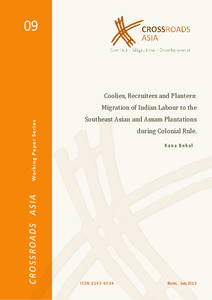Coolies, Recruiters and Planters: Migration of Indian Labour to the Southeast Asian and Assam Plantations during Colonial Rule

Coolies, Recruiters and Planters: Migration of Indian Labour to the Southeast Asian and Assam Plantations during Colonial Rule

| dc.contributor.author | Rana, Behal | |
| dc.contributor.editor | Baldauf, Ingeborg | |
| dc.contributor.editor | Conermann, Stephan | |
| dc.contributor.editor | Kreutzmann, Hermann | |
| dc.contributor.editor | Nadjmabadi, Shahnaz | |
| dc.contributor.editor | Reetz, Dietrich | |
| dc.contributor.editor | Schetter, Conrad | |
| dc.contributor.editor | Sökefeld, Martin | |
| dc.contributor.editor | Hornidge, Anna-Katharina | |
| dc.date.accessioned | 2016-10-05T12:45:01Z | |
| dc.date.available | 2016-10-05T12:45:01Z | |
| dc.date.issued | 07.2013 | |
| dc.identifier.uri | https://hdl.handle.net/20.500.11811/132 | |
| dc.description.abstract | This paper attempts to tell the story of marginalized agrarian communities, who were economically depressed as a consequence of colonial land revenue policies and became the hunting ground for recruitment and transportation as emigrant labour for Assam, Ceylon and Malaya plantations. With the introduction of alien land tenures, the colonial state dispossessed large sections of these communities. This brought about the creation of an enormous population that had been alienated and uprooted from their land, the main source of their livelihood (Ghosh 1999). Various aspects of different recruitment and transportation systems bringing a very diverse range of Indian agrarian communities from different geographical locations to work as labour there in the nineteenth and early twentieth centuries will be compared. The study will focus on two important areas of this labour mobilization and transportation across geographic locations in the British Empire: (a) the agencies of recruitment and recruitment systems, i.e., the European recruiting agents, the indigenous kanganies, sirdars and arkatis; and (b) the nature and process of transformation of the immigrant Indian agrarian communities while performing labour in the plantations set up in the enclaved, isolated and sparse geographical localtions in Malaya, Ceylon and Assam. In order to understand the processes of mobilization and transformation of immigrant Indian labour, they will have to be placed within the larger context of the fluctuating fortunes of these colonial plantation enterprises in the world market, which impacted the nature of demand and supply of labour force. Equally significant will be the study of the networks of recruitments and recruiters across spatial boundaries and localities that operated under the control and supervision of the colonial state and British capital. This study contributes to Crossroads Asia research on the long-term impact migration has on social change among communities who were mobilized across geographic spaces. The paper introduces a new trajectory in the debate on migration. The Indian agrarian communites were first demobilized from their catchment areas and mobilzed to work in the plantations set up with British capital across borders and distant frontiers of the British Empire. Upon arrival they were immobilized within geographically sparse and isolated locations to meet the increasing labour requirements of producing plantation coomodities for fast growing global markets. During the process of demobilization, mobilization and imobilization, these agrarian communities were transformed into plantation coolies to be a ‘tamed’, ‘disciplined’ and controlled labour force. | en |
| dc.format.extent | 35 | |
| dc.language.iso | eng | |
| dc.relation.ispartofseries | Crossroads Asia Working Paper Series ; 9 | |
| dc.rights | In Copyright | |
| dc.rights.uri | http://rightsstatements.org/vocab/InC/1.0/ | |
| dc.subject | Labour migration | |
| dc.subject | Labour mobilization | |
| dc.subject | India | |
| dc.subject | Colonial rule | |
| dc.subject | British Empire | |
| dc.subject | Assam | |
| dc.subject | Ceylon | |
| dc.subject | Malaya | |
| dc.subject.ddc | 320 Politik | |
| dc.title | Coolies, Recruiters and Planters: Migration of Indian Labour to the Southeast Asian and Assam Plantations during Colonial Rule | |
| dc.type | Arbeitspapier | |
| dc.publisher.name | Competence Network Crossroads Asia: Conflict – Migration – Development | |
| dc.publisher.location | Bonn | |
| dc.rights.accessRights | openAccess | |
| dc.relation.eissn | 2192-6034 | |
| dc.relation.url | http://crossroads-asia.de/veroeffentlichungen/working-papers.html | |
| ulbbn.pubtype | Zweitveröffentlichung |
Dateien zu dieser Ressource
Das Dokument erscheint in:
-
Crossroads Asia Working Paper Series (37)
Working Paper des Kompetenz-Netzwerks Crossroads Asia




